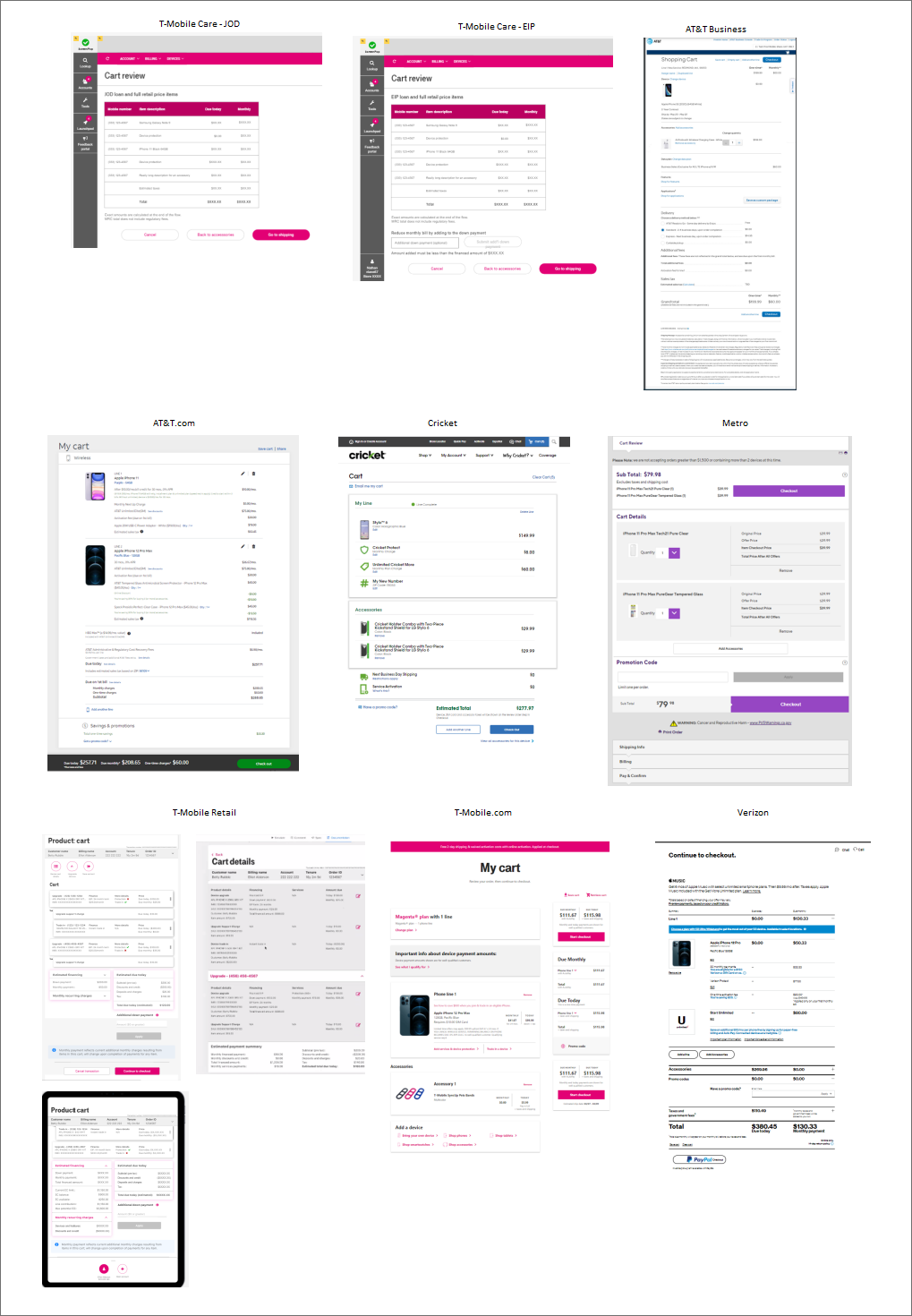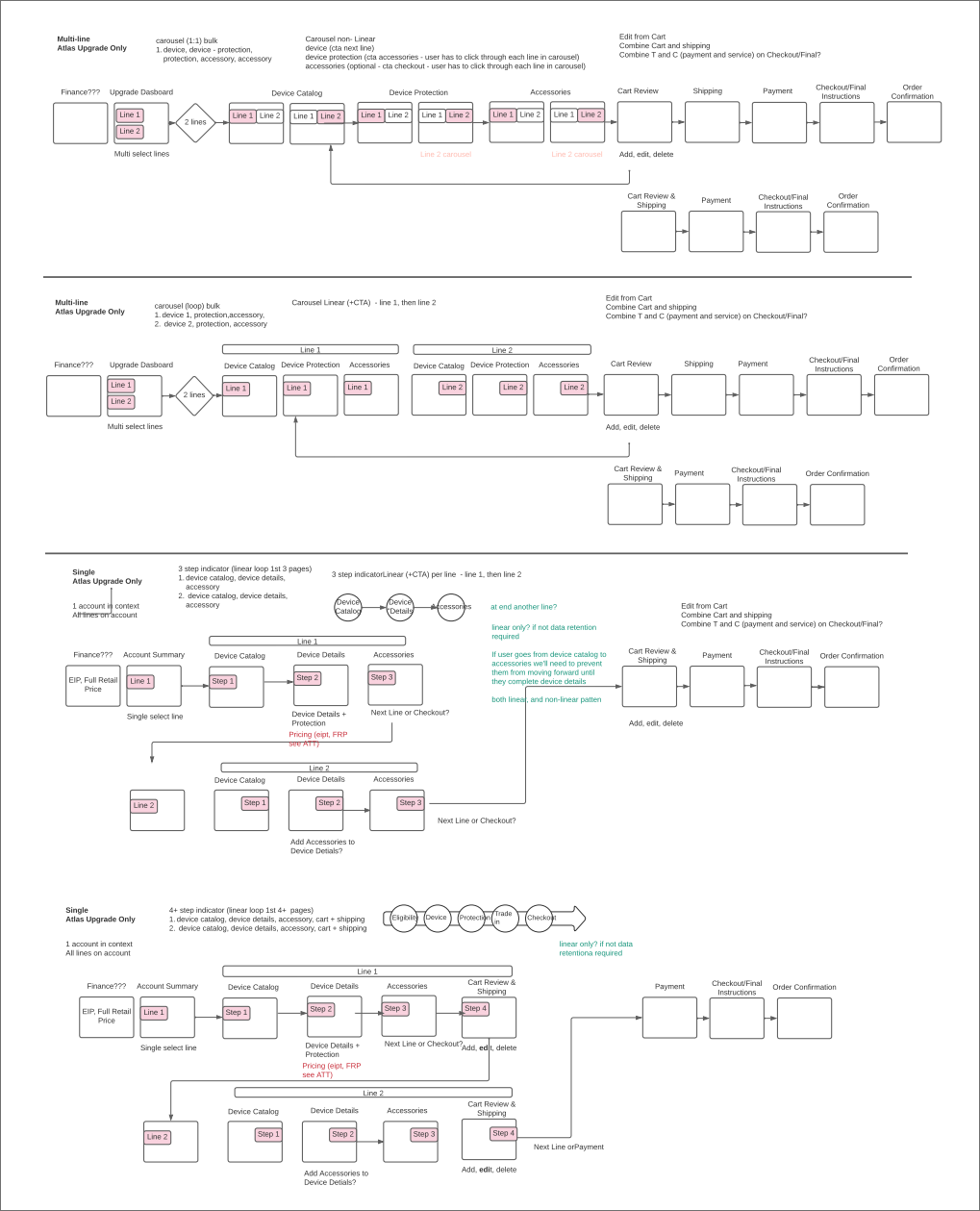Overview
Atlas represents a web-based application and shared platform which serves Frontline Customer Care specialists with internal service and management tools. This includes 3 pillars: Sell, Serve, Platform. The Sell platform delivers all shop experiences: upgrade, upgrade w/trade-in, trade-in, accessory only. The Connected Cart upgrade project will provide a one-stop unified shopping experience including an omni-channel connected cart. The team is focused on building a seamless upgrade and trade-in experience that will reduce the cognitive load of the users and allow the specialists to monitor and manage the processes more efficiently.
Defining the Problem
Currently QVXP provides the ability to initiate device upgrades. To allow Care specialists to better serve the needs of customers, this project will migrate the upgrade experience from QVXP to Atlas.
Along with creating a new streamlined selling experience to ensure our specialists have the most accurate, efficient, transparent, and user-friendly experience from the time they start to shop until they have submitted the order. This change will also allow for a more consistent experience with other Atlas tools, therefore improving two key metrics: call resolution time and customer satisfaction.
Goals
In collaboration with internal design and research teams, product management, business, and development partners:
- Leverage Atlas to present a unified experience for the device upgrade flow for EIP, JUMP and JUMP/JOD customers
- Establish and deliver a world-class experience for upgrades and shopping workflows
- Eliminate swivel chair between multiple applications and workflows
- Deliver 9 new micro apps for an orchestrated modular workflow management solution in Sell Pillar shell
- Update the DCP Connected Cart with data captured during customer interaction (e.g. selected device)
- Introduce Design Thinking to further facilitate defining the process, explore new design options, and deliver a best-in-class user experience
Requirements
- Build an enterprise cart that leverages APIs created for eCommerce and make those available to the assisted channels of Retail, Telesales, and Care, enabling customers to initiate their cart in any channel and then pick back up in the same or any other channel later
- New flow for Upgrade including EIP, JOD/JUMP
- New flow for Upgrade and standard trade-in
- Shop now landing page provides line and account level specific actions (line: upgrade, trade-in, accessory only and account: HINT, change rate plan, add a line)
- Device catalog
- Summary
- Trade-in
- Accessory catalog
- Cart review
- Cart drawer
- Checkout – shipping
- Checkout – payment
- Confirmation
Design Principles and Metrics
Design Principles:
- Simple: deliver a consistent way to get started and a clear path to accomplish the task
- Smart: customize the experience based on users purchase intention, increase confidence
- Personal: provide a one-stop shopping experience within Atlas into the hands of Care specialists
Metrics:
- Improve customer experience and increase satisfaction
- Reduce call resolution time
- Radical cost to serve reductions
Use Case Study
Analysis
Comparative and competitive analysis of e-commerce shopping carts

Concepting and Brainstorming
Upgrade purchase flow – linear (multiple lines w/carousel) vs non-linear (single line w/step indicator)

Research
Care specialists continue to position and sell phone devices and accessories to the customer. Research explores how they think and talk about these sales opportunities, in terms upgrades and trade-ins.
The design and research teams conducted the following 4 research tests + prototypes during the project lifecycle to iterate and improve the design, and to understand the users’ needs:
- Existing cPivot upgrade flow discovery research
-1 use case/23 pages = multiple upgrades simultaneously - New upgrade flow and design within the Connected Cart experience (navigation, functionality, interaction, content, layout)
-6 use cases/49 pages = linear (multiple lines w/carousel) vs non-linear (single line w/step indicator) - Atlas mini-cart – 3 new designs via design thinking workshop
-3 use cases/37 pages = cart tab, shop tab, Expert Assist - Atlas trade-in with Jump/JOD
-2 use cases/57 pages = upgrade to a new phone and trade-in current phone
Connected Cart upgrade w/trade-in

Design Thinking Workshop
Sell Pillar – Mini-cart
- Vision statement
- Problem statement
- Sales journey
- Knowledge base
- Project requirements
- Inspiration
- Sketches
- Concept prototypes for research

UX Quality Assurance Testing
Connected Cart upgrades

Solving the Problem
Issues I addressed including areas of improvement:
- Fostered partnerships with business, development, product teams to define and deliver a seamless and streamlined end-to-end shopping experience by reducing the number of flows and pages based on a legacy application which expedited time to market
- Revolutionized the current landscape of multiple fractured, swivel chair and vague experiences into a coherent experience that can start, and finish based on customer needs
- Delivered a more consistent experience with other Atlas tools, improving call resolution time and overall customer satisfaction
Reflection
Wow! What a fantastic opportunity to design and build a one-stop unified shopping experience which empowers our specialists to delight customers through world-class service and unlock sales opportunities. Unfortunately, after nearly a year of design and development the Connected Cart upgrades project was placed on hold due to budget constraints in Q4/2022 and will be re-evaluated for launch in Q1/2023.